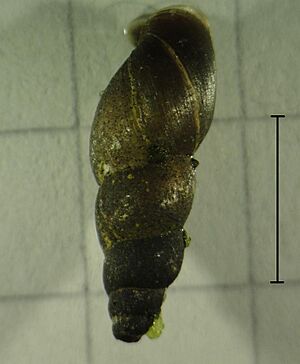Pond mud snail facts for kids
Quick facts for kids Pond mud snail |
|
|---|---|
 |
|
| A live individual of Omphiscola glabra on a paper grid, scale bar 1 cm | |
| Scientific classification | |
| Synonyms | |
|
The Omphiscola glabra, also known as the pond mud snail, is a small to medium-sized snail that lives in fresh water. It breathes air and is a type of gastropod mollusk from the Lymnaeidae family. This snail is the main example for its group, called Omphiscola.
Contents
Where These Snails Live
You can find this European snail from southern Scandinavia all the way down to southern Spain.
Sadly, the pond mud snail is in danger in many places:
- It is endangered in Germany. It's even critically endangered (meaning very, very close to disappearing) in parts of Western Germany like Rheinland-Pfalz and Nordrhein-Westfalen. It has already disappeared from Bavaria.
- It lives in the Netherlands.
- In Ireland, a group was found in 2009, but the snail is now listed as extinct there.
- It is vulnerable (meaning at risk) in Great Britain.
The pond mud snail is very rare and its groups are spread out. It is seriously threatened and has vanished from many areas. This is mostly because its habitat (the place where it lives) is being destroyed. This happens due to things like drainage (removing water) and intensive farming (farming that uses a lot of land and chemicals). Also, too many nutrients from farms getting into the water, called eutrophication, is a big problem. The pond mud snail has mostly disappeared from big cities like London.
What Their Shells Look Like
The snail's shell is shaped like a strong cylinder. It often has a brownish or blackish surface. The very top part of the shell, called the apex, is blunt or rounded.
The shell has 7 to 8 whorls, which are like the turns of a spiral staircase. These whorls are a bit rounded. The very last whorl is twice as tall as the narrow opening, called the aperture. This opening often has a white edge.
The height of the shell is usually between 9 and 12 millimeters (about 0.35 to 0.47 inches). Some can grow up to 15 or even 20 millimeters. The width of the shell is about 3 to 4 millimeters (about 0.12 to 0.16 inches), and some can be up to 5.5 millimeters wide.
Where They Live and Thrive
These snails like to live in wet places such as swampy meadows and ditches.
Omphiscola glabra is often found in small areas of still water that have a lot of plants, like swamps. They also live in still forest waters where there are many fallen leaves. These waters often have iron in them and not much calcium.
In Central France, the number of pond mud snails is going down. This is because their homes are threatened by modern farming methods.
In Britain, however, this snail lives in small, still waters that don't have many nutrients. These places often have few water plants and sometimes dry out for a while. They usually don't live in places with many different types of snails. They are often found in areas that haven't been farmed. They like water with calcium and can live in water with a pH level between 5.4 and 8.8.
Reproduction and Life Cycle
The pond mud snails start to reproduce in May. Their young snails hatch from eggs after about 15 to 25 days. The Omphiscola glabra usually has two generations (sets of babies) born each year.
Snail Parasites
The Omphiscola glabra can be a temporary home for certain types of tiny worms called digenean trematodes. These worms are parasites, meaning they live inside another animal and get their food from it.
In France, the pond mud snail can naturally get infected with parasites like Fasciola hepatica, Calicophoron daubneyi, and Haplometra cylindracea. In total, seven different kinds of these tiny worms can live inside O. glabra in the Brenne Regional Natural Park. There is also a report that suggests this snail can be infected by Fascioloides magna.
Images for kids



